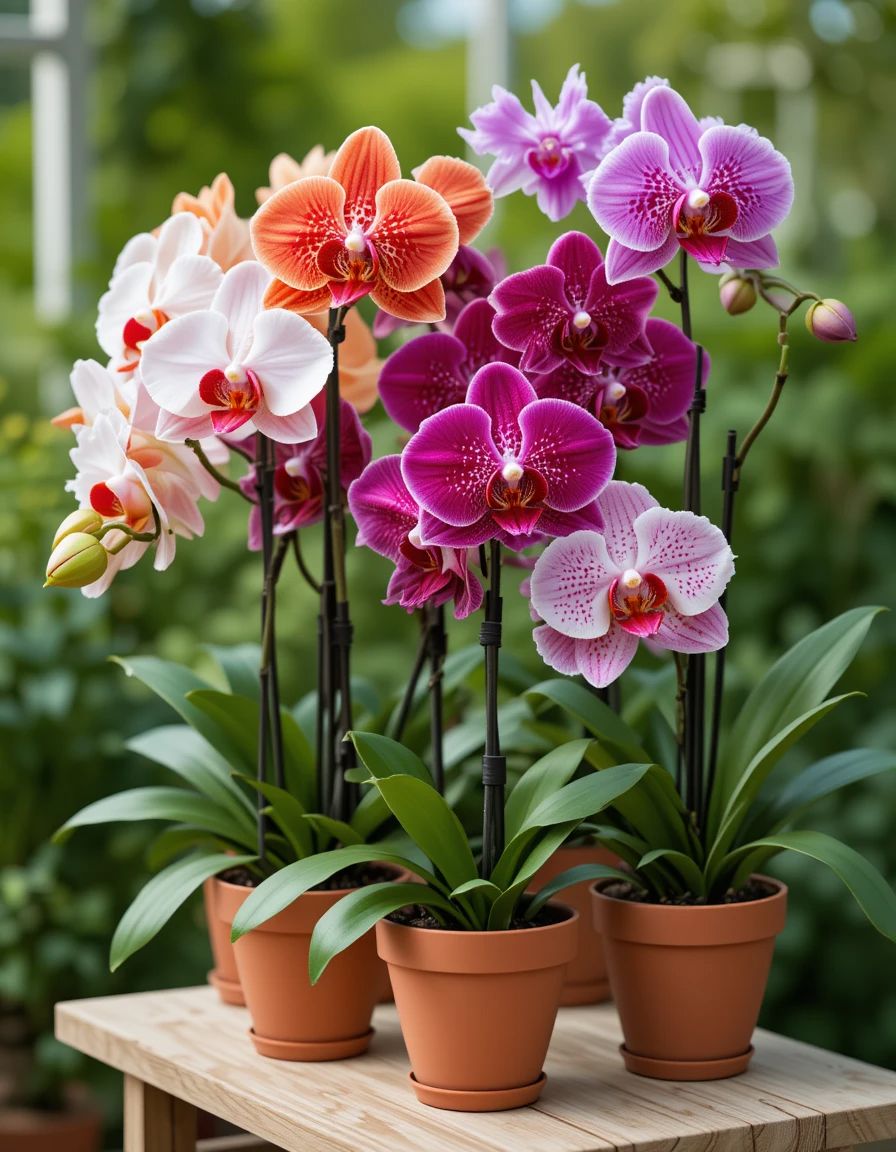Phalaenopsis orchids, commonly known as Moth Orchids, are one of the most popular and widely available types of orchids. Their elegant, long-lasting blooms and relatively easy care make them a favorite among both beginner and experienced gardeners. Whether you’re new to orchid care or looking to refine your skills, this guide will walk you through everything you need to know to keep your Phalaenopsis orchids thriving and blooming beautifully.
Why Choose Phalaenopsis Orchids?
- Long-Lasting Blooms: Phalaenopsis orchids can bloom for several months, with flowers lasting 2-3 months or more.
- Low Maintenance: Compared to other orchids, they are easier to care for and adapt well to indoor environments.
- Variety of Colors: They come in a wide range of colors, including white, pink, purple, yellow, and even striped or spotted varieties.
Growing Conditions for Phalaenopsis Orchids
To keep your Moth Orchids healthy and blooming, it’s essential to replicate their natural tropical habitat. Here’s how to create the perfect environment:
1. Light Requirements
Phalaenopsis orchids thrive in bright, indirect light. Too much direct sunlight can scorch their leaves, while too little light can prevent blooming.
- Ideal Placement: Place your orchid near an east- or west-facing window where it can receive gentle morning or afternoon light.
- Signs of Too Much Light: If the leaves turn yellow or develop brown spots, move the plant to a shadier spot.
- Signs of Too Little Light: Dark green leaves and lack of blooms indicate insufficient light.
Pro Tip: Use sheer curtains to filter harsh sunlight if needed.
2. Temperature
Phalaenopsis orchids prefer warm, stable temperatures similar to their native tropical environment.
- Daytime Temperature: 65-80°F (18-27°C).
- Nighttime Temperature: A slight drop to 60-65°F (15-18°C) can encourage blooming.
- Avoid Cold Drafts: Keep your orchid away from cold windows, air conditioners, or heaters.
Pro Tip: A consistent temperature is key to preventing stress and promoting healthy growth.
3. Humidity
These orchids love moderate to high humidity (50-70%). Dry air can cause bud drop and slow growth.
- Humidity Tray: Place the orchid pot on a tray filled with pebbles and water. Ensure the pot isn’t sitting directly in the water.
- Humidifier: Use a humidifier to maintain consistent humidity levels, especially during winter.
- Misting: Lightly mist the leaves occasionally, but avoid getting water in the crown (center of the plant), as this can cause rot.
4. Watering
Proper watering is crucial for Phalaenopsis orchids. Overwatering is the most common cause of problems, including root rot.
- When to Water: Water when the potting medium is almost dry. Stick your finger about an inch into the medium—if it feels dry, it’s time to water.
- How to Water: Water thoroughly until it drains out of the bottom of the pot. Never let the orchid sit in standing water.
- Water Quality: Use room-temperature water. Rainwater or distilled water is ideal, as tap water can contain chemicals that harm the plant.
Pro Tip: Water less frequently during the winter when the plant’s growth slows down.
5. Potting Medium
Phalaenopsis orchids need a well-draining potting mix that allows air to reach their roots.
- Orchid-Specific Mix: Use a mix designed for orchids, typically made of bark, sphagnum moss, perlite, or a combination.
- Avoid Soil: Never use regular potting soil, as it retains too much moisture and can suffocate the roots.
6. Fertilizing
Regular feeding helps your orchid grow strong and produce abundant blooms.
- Fertilizer Type: Use a balanced orchid fertilizer (e.g., 20-20-20) diluted to half strength.
- Frequency: Fertilize every 2-4 weeks during the growing season (spring and summer). Reduce feeding in fall and winter.
- Application: Water the orchid first, then apply the fertilizer solution to avoid burning the roots.
Pro Tip: Flush the potting medium with plain water every month to prevent salt buildup from fertilizers.
7. Repotting
Repotting is essential to refresh the potting medium and provide room for growth.
- When to Repot: Repot every 1-2 years, or when the potting medium breaks down and becomes compacted.
- Signs It’s Time to Repot: Roots growing out of the pot, poor drainage, or a decomposed medium.
- How to Repot:
- Gently remove the orchid from its pot and shake off the old medium.
- Trim any dead or rotting roots with sterilized scissors.
- Place the orchid in a slightly larger pot with fresh orchid mix.
Pro Tip: Repot after the orchid has finished blooming to minimize stress.
Common Problems and Solutions
1. Yellow Leaves
- Cause: Overwatering, too much light, or nutrient deficiency.
- Solution: Adjust watering, move to a shadier spot, or fertilize regularly.
2. Bud Drop
- Cause: Sudden temperature changes, low humidity, or underwatering.
- Solution: Maintain consistent conditions and increase humidity.
3. Root Rot
- Cause: Overwatering or poor drainage.
- Solution: Repot the orchid in fresh medium and ensure proper drainage.
Conclusion: Enjoy the Beauty of Phalaenopsis Orchids
With their stunning blooms and relatively easy care, Phalaenopsis orchids are a joy to grow. By providing the right light, temperature, humidity, and care, you can enjoy their beauty for years to come. Whether you’re a beginner or an experienced gardener, these tips will help you grow Moth Orchids like a pro.
So, bring home a Phalaenopsis orchid, follow this guide, and watch it thrive. Before you know it, you’ll be rewarded with long-lasting blooms that add elegance and charm to your home. Happy growing! 🌸
